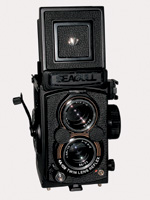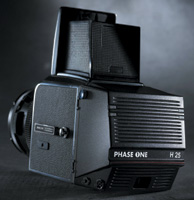Medium Format Update
Does 120 220 Offer The Best Of Film, And Digital
When it comes to image quality combined with convenience it's hard to match medium format. Simple physics tell the tale: the larger film size means less magnification to get to equivalent image sizes--in print or repro--than the smaller 35mm format. In addition, medium format cameras are, in general, made for pros, so lenses, accessories, and add-ons are made for demanding eyes and hands. These days medium format also means digital adapters, be they for scanning or "live" action photography, with CCDs of larger size and greater pixel count and thus larger file sizes for even bigger prints with finer resolution. And if you scan a medium format film you can get larger file sizes and subsequent prints with as much upscaling percentage as from 35mm. Given the right scanner (and the new ones are yielding higher resolution at lower cost) medium format film scans can yield higher quality images time after time. |
|
You'd think that if quality
were the measure then medium format would have it all over other image-making
tools, but sales figures these days seem to defy that logic. Ever since
high-end digital SLRs made their appearance medium format has struggled
to keep up, at least when it comes to sales. This may come down to simple
economics--if you have to choose between buying a medium format camera
and an advanced digital SLR, and everyone is telling you that digital
is the wave of the future, which way would you go? And medium format digital
backs have yet to enter the realm of the affordable for all but the busiest
pros who can justify the expense with bookings. |
|
New Hasselblad H1 Lenses |
|
In other news from Hasselblad, the company has announced the Leaf Valeo 22, a 22-megapixel digital back with a CCD measuring 36x48mm (nearly the exact full frame format of the H1) that eliminates lens factors. The huge 126MB 16-bit files produce over 65,000 levels per color channel. The Leaf back is said to be matched to the optical performance of the lenses designed for the H1 system. |
|
The Leaf Portable Power Solution allows the system to operate with complete portability using the on-board Digital Magazine with the capacity to hold over 200 full resolution, uncompressed images. The battery-powered solution mounts directly to the bottom of the Hasselblad H1. The Leaf PD67, a large 6x7cm screen that acts as a "digital proof," offers an image preview. Rollei's 6008
AF |
|
Fujifilm's GX680III |
|
Contax's 645 |
|
Bronica's RF645
|
|
Pentax's 645NII |
|
Mamiya's 645AFD |
|
Mamiya has made a real good
effort in terms of "digitizing" medium format. The Leaf Mamiya
ProDigital 6 is a marriage between the Leaf backs and the Mamiya cameras.
It also works with the Leaf Portable Power Solution, mentioned earlier.
The ProDigital system now also includes 12 and 22-megapixel versions.
There's also a pretty good price promotion going on right now--check
with your Mamiya dealer. |
|
Just Add Lens |
|
Panoramic Options |
|
Affordable Option |
|
If you're looking for affordable options in the single lens reflex class the Kiev cameras are worth consideration. The Kiev line-up is available in square format as well as 6x4.5. The Kiev 88 (the square format) has a full line-up of interchangeable lenses, from 30-250mm and can be used with interchangeable film magazines (6x6 and 6x4.5), an instant proofing back, and a host of accessories. The camera has a bright finder, interchangeable eye-level penta-prism viewfinders with or without built-in full aperture TTL metering, 10 programmed speeds from 1/2 to 1/1000 sec, plus Bulb and an FP-X electronic flash sync. You can also get a Kiev 88 Series Kit that includes the camera with an 80mm f/2.8 lens, waist-level or TTL finder, a rubber lens shade, strap, tripod reducing bushing, a 62mm filter set, and the company's exclusive one-year warranty. Full details on this and their other cameras and accessories are available on the company's website at www.kievusa.com. |
|
Digital Backs |
|
The Phase One H 25 can deliver up to 22 megapixels in a form that can fit a variety of Hasselblad (including their wide angle 903SWC), Mamiya, Horseman, and view camera bodies. It hooks up to Mac or PC computers via FireWire. The unit can be used in an ISO range of 50-400 and can be used in single or two-shot mode, up to 64-bit CMYK. It's said to have a dynamic range of 12 stops and delivers 16 bits per color. |
|
While there is a lack of new models and products, at least this time around, there is a growing sense of a renewed interest in this most respectable format. Indeed, one maker told me that some photographers who tried digital SLRs for wedding work were dissatisfied and were returning to medium format film shooting. That makes sense, but then again you must consider the source. In general, some folks predict that medium format might be the first victim of the higher digital SLR pixel counts. But then again, that's what's been said of film all along, and it's still with us, and will remain so for many years to come. |
- Log in or register to post comments



















































